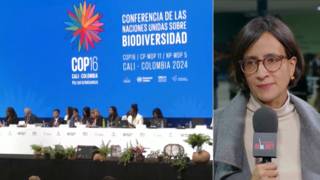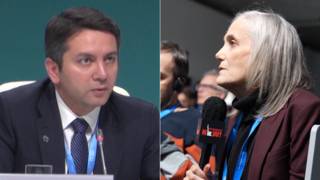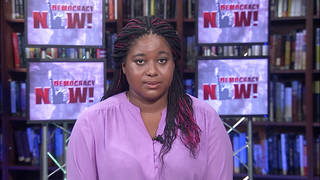
Related
Democracy Now! co-host Juan González discusses how video of the Walter Scott killing echoes other videos of police shootings, such as Tamir Rice in Cleveland and Eric Garner in New York City. “People wonder why the Black Lives Matter movement has grown and spread so rapidly across the country,” González notes, “when people are seeing these videos where people who are shot and not even given immediate aid.” González writes about the issue in his new column for the New York Daily News headlined “When Will the Killings of Black Males by Cops Cease?”
Transcript
AMY GOODMAN: The news about South Carolina just continues with the release of the dash cam video, Juan, and you wrote your commentary today in the New York Daily News, your column on South Carolina.
JUAN GONZÁLEZ: Yes, I think one of the things that I tried to stress in my column is that—how many more of these heartbreaking videos are we going to be exposed to across the country before a change occurs in policing in the country? And I think the critical thing to understand is not only the videos, the videos of the actual encounters, where African-American males are killed by police, but also what happens in the moments afterward. And we now have seen several of these—the Tamir Rice video in Cleveland in November, where the 12-year-old boy is shot by a policeman who arrives within two seconds of his getting out of the car, but then for four minutes after, as the boy is lying on the ground, three police officers just stand around, walk around. No one provides him any kind of aid until an FBI agent, who happens to be in the neighborhood, comes along, and he begins to administer CPR to Tamir Rice.
AMY GOODMAN: And when Tamir’s sister came running over, who was just 14 years old—
JUAN GONZÁLEZ: Right, right, she gets tackled.
AMY GOODMAN: —they tackle her—
JUAN GONZÁLEZ: They tackle her.
AMY GOODMAN: —and put her in the cruiser.
JUAN GONZÁLEZ: And they handcuff her, push her to the ground, handcuff her and prevent her from getting to her brother.
Then you have the situation with Eric Garner in the Staten Island video, where not only half a dozen police officers stand around as Eric Garner is gasping for breath, but then even when the EMS, the paramedics arrive, they waste four crucial minutes, while they are walking around not treating him. Those four paramedics were eventually suspended for their actions on that day.
And then, of course, now we have the South Carolina situation, where, once again, after Officer Slager shoots Walter Scott, and another African-American officer arrives on the scene, Habersham, they stand around. Habersham checks for the wounds. They talk on their radios. They discuss where is my vehicle. But they don’t administer any kind of aid to Walter Scott.
So you have this, and then people wonder why the Back Lives Matter movement has grown and spread so rapidly across the country, when people are seeing these videos where people who are shot are not even given immediate aid.
AMY GOODMAN: And police use their force to prevent bystanders from administering aid.
JUAN GONZÁLEZ: Yes.
AMY GOODMAN: When you look at Ramsey Orta’s film—and again, Ramsey Orta remains in Rikers Island, the only person arrested around the Eric Garner case, though it was in an unrelated charge. He’s the one who videoed. When you look at that video and listen, bystanders are saying, “Help him. Help him.” The police use their authority to prevent anyone to help him, and then they themselves don’t help.
JUAN GONZÁLEZ: Right, and then people wonder why there’s such anger spreading across the country.
AMY GOODMAN: Well, of course, we will continue to follow this story, and we’ll link to your column at democracynow.org.












Media Options